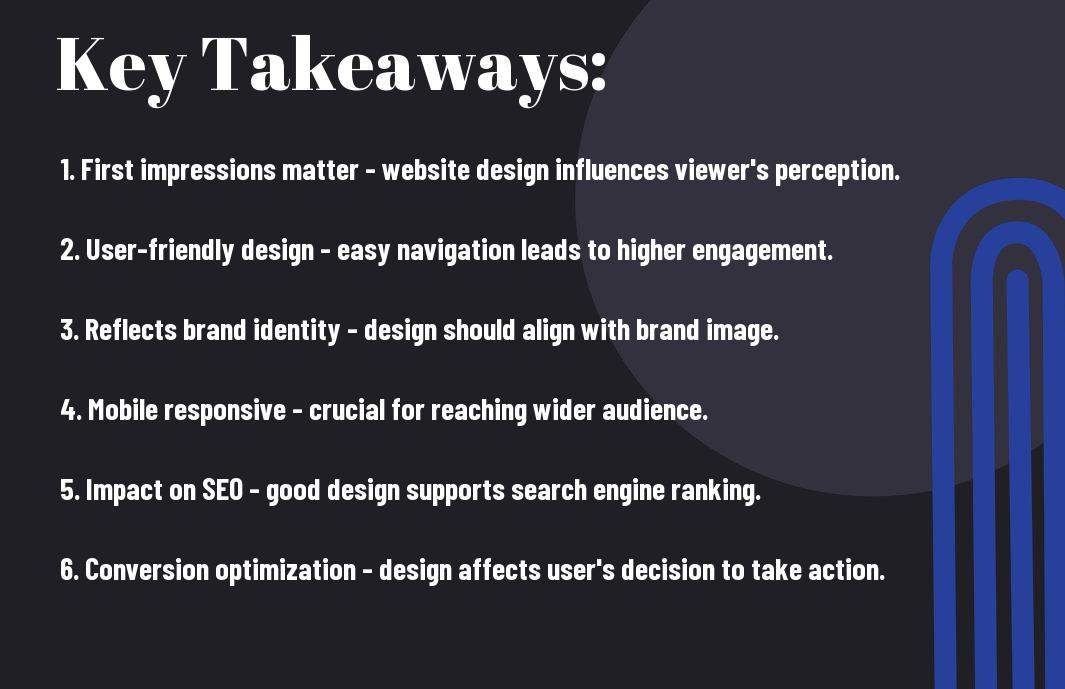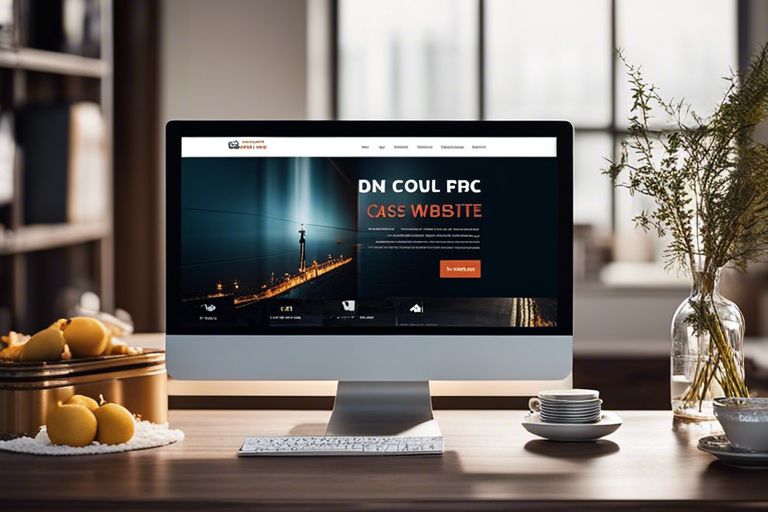When it comes to online advertising, one aspect that cannot be overlooked is the design of your website. Your website is often the first impression that potential customers have of your brand, and it needs to be visually appealing, user-friendly, and reflective of your brand identity. A poorly designed website can turn potential customers away and ultimately hurt your advertising efforts. First impressions are crucial in the digital world, and your website’s design plays a significant role in shaping these impressions. In this blog post, we will dive into the reasons why website design is essential for successful online advertising, and how it can impact the success of your advertising campaigns. Whether you are a small business owner or a marketing professional, understanding the importance of website design is key to the success of your online advertising efforts.
Key Takeaways:
- First Impressions Matter: An attractive and professional website design can make a significant impact on how a potential customer perceives a brand.
- User Experience Is Key: A well-designed website can enhance the user experience, making it easier for visitors to find information and navigate through the site.
- SEO Optimization: Website design plays a crucial role in search engine optimization, affecting the site’s visibility and search ranking on the web.
- Brand Image and Credibility: A visually appealing and well-designed website can help establish a brand’s credibility and create a positive brand image.
- Conversion and Lead Generation: A well-optimized and user-friendly website design can lead to higher conversion rates and more leads for a business.

Fundamentals of Effective Website Design
If you want to create a successful online advertising campaign, it’s essential to understand the fundamentals of effective website design. Your website is the virtual storefront of your business, and it’s often the first interaction potential customers have with your brand. A well-designed website can capture the attention of visitors, convey your brand message, and ultimately drive conversions. In this chapter, we’ll explore the key principles of website design that can help you create a powerful online presence and boost your advertising efforts.
User Experience (UX) Principles
When it comes to website design, user experience (UX) is crucial. Your website should be easy to navigate, visually appealing, and offer a seamless browsing experience. When a visitor lands on your site, you want to make sure they can find what they’re looking for quickly and efficiently. This means prioritizing clear navigation, intuitive design, and fast loading times. By focusing on user experience, you can keep visitors engaged and encourage them to explore your site further, ultimately increasing the likelihood of conversion.
Visual Hierarchy and Layout
The visual hierarchy and layout of your website play a significant role in capturing and retaining your visitors’ attention. When someone lands on your site, the layout should guide them through the content in a logical and intuitive manner. This involves strategically placing key information, using appropriate fonts and colors, and creating a visually appealing design. A well-thought-out visual hierarchy can draw attention to important elements, such as calls-to-action, product features, or special offers, leading to higher engagement and conversion rates.

Role of Website Design in Advertising Success
Keep in mind that the design of your website plays a crucial role in the success of your online advertising efforts. Your website is often the first interaction potential customers have with your brand, and it’s important to make a positive and lasting impression. A well-designed website can set you apart from the competition and help you drive more traffic, leads, and conversions.
Brand Consistency and Recognition
When it comes to online advertising, brand consistency and recognition are key. Your website design should reflect your brand’s identity, values, and messaging. By maintaining a cohesive look and feel across all of your online advertising channels, you can reinforce brand recognition and build trust with your audience. Consistent branding also makes it easier for you to stand out in a crowded marketplace and create a memorable experience for your potential customers.
Improving Conversion Rates
Your website design can directly impact your conversion rates. A well-structured, visually appealing, and user-friendly website can help you guide visitors through the buyer’s journey and encourage them to take the desired actions, such as making a purchase or filling out a form. By optimizing your website design for conversions, you can increase the likelihood of turning visitors into customers. This includes using clear calls-to-action, intuitive navigation, and a responsive design that ensures a seamless experience across devices.
Web Design Elements That Influence Ad Effectiveness
To maximize the effectiveness of your online advertising, it’s essential to consider the impact of your website’s design elements. Your website’s design plays a critical role in attracting and engaging visitors, which directly influences the success of your online advertising efforts. If you want to learn more about why web design is important, you can visit Why Is Web Design Important? | 6 Reasons to Invest.
Mobile Responsiveness
When it comes to online advertising, the mobile experience is crucial. With more people accessing the internet on mobile devices, a mobile-responsive website is essential for ensuring that your ads are effectively reaching your audience. If your website is not mobile-friendly, you could be losing out on a significant number of potential customers. Having a mobile-responsive website is not only important for user experience but also for search engine rankings. Ensure that your website is optimized for various screen sizes and devices to provide a seamless experience for your visitors.
Load Times and Technical Performance
The speed and technical performance of your website can directly impact the effectiveness of your online advertising. Slow load times can lead to high bounce rates, negatively affecting your ad performance and conversions. Users expect websites to load quickly, and if yours doesn’t, they may look elsewhere. Optimizing your website for speed and technical performance is crucial for ensuring that your ads lead to positive user experiences. Implementing strategies such as image optimization, minifying CSS and JavaScript, and utilizing content delivery networks can help improve your website’s performance and overall ad effectiveness.
Measuring the Impact of Web Design on Advertising
After investing time and resources into your website design, you naturally want to measure the impact it has on your advertising efforts. Understanding the correlation between web design and advertising is crucial for optimizing your online marketing strategy. For a more comprehensive look at this topic, you can also check out the Importance of Web Design in Digital Marketing Strategy.
Analytics and User Behavior
Analytics and user behavior play a significant role in gauging the impact of your web design on your advertising efforts. By analyzing metrics such as bounce rate, conversion rate, and user engagement, you can gain valuable insights into how your website design is influencing the effectiveness of your advertising campaigns. Understanding these metrics allows you to make data-driven decisions to refine your web design and enhance your advertising performance.
Case Studies and Industry Examples
Case studies and industry examples provide concrete evidence of the impact that web design can have on advertising. For example, a study conducted by Convert found that websites with a clear call-to-action (CTA) and prominent contact information can increase leads by 70%. Similarly, HubSpot reported that companies that prioritize blog design experience an average increase in traffic by 153%. By examining real-world examples, you can gain valuable insights into the tangible benefits of effective web design for advertising.
- Convert study: showed websites with clear CTA and prominent contact information increase leads by 70%.
- HubSpot report: companies that prioritize blog design experience an average increase in traffic by 153%.
By leveraging analytics and examining case studies, you can gain a deeper understanding of how your web design impacts your advertising, enabling you to refine your approach and drive better results.
The Importance of Website Design in Online Advertising
With this in mind, it is crucial for you to understand the impact that website design has on your online advertising efforts. A well-designed website not only captures the attention of your audience, but it also enhances the user experience, encourages engagement, and ultimately increases the likelihood of conversion. Your website is the first impression you make on potential customers, so it is important that it effectively communicates your brand message and values. Additionally, a well-designed website is more likely to rank higher in search engine results, driving further traffic to your site. Overall, investing in professional website design is essential for the success of your online advertising strategies.
FAQ
Q: Why is website design important in online advertising?
A: The design of your website directly impacts your online advertising efforts. A well-designed website can attract and engage potential customers, while a poorly designed website can drive them away. It is crucial to have a visually appealing and user-friendly website to effectively advertise your business online.
Q: How does website design affect online advertising?
A: Website design affects online advertising in several ways. A visually appealing and professional-looking website can enhance brand credibility and trust, leading to higher conversion rates. Additionally, a well-organized website with intuitive navigation can improve user experience, ultimately boosting the effectiveness of online advertising campaigns.
Q: What are the key elements of a good website design for online advertising?
A: Key elements of a good website design for online advertising include a responsive layout for mobile compatibility, clear and persuasive call-to-action buttons, high-quality images and graphics, fast loading times, and easy-to-read content. These elements play a crucial role in attracting and retaining visitors from online advertising channels.
Q: How can website design help with search engine optimization (SEO) for online advertising?
A: A well-designed website can significantly impact SEO efforts for online advertising. Properly structured and optimized website design elements, such as meta tags, headings, and sitemaps, can contribute to better search engine rankings. Additionally, a user-friendly and engaging website design can reduce bounce rates and increase the time visitors spend on your site, which are important SEO factors.
Q: What are the consequences of neglecting website design in online advertising?
A: Neglecting website design in online advertising can lead to negative consequences for your business. A poorly designed website may result in high bounce rates, low conversion rates, and a negative perception of your brand. Ineffective online advertising campaigns and wasted marketing budgets are common outcomes of neglecting the importance of website design. It is essential to prioritize website design to maximize the effectiveness of online advertising efforts.
